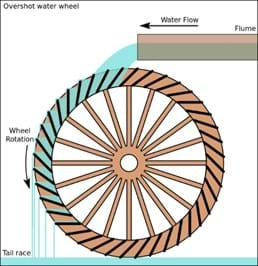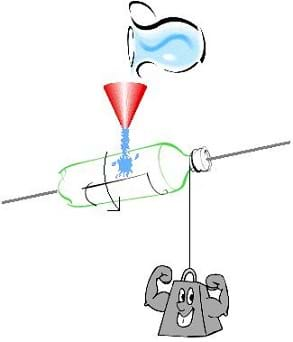Quick Look
Grade Level: Middle school
Time Required: 1 hour
Expendable Cost: US $1.00
Group Size: 3
Subject Areas: Algebra, Physical Science, Physics
Introduction
Bolded words are vocabulary and concepts to highlight with students during the activity.
Civil, geotechnical, environmental, mechanical and electrical engineers collaborate to design and construct dams that generate electricity from the flow of water. When engineers design these dams, called hydroelectric power plants, they calculate the amount of power that can be generated by the plant. Knowing the dam's potential power generation, they can further estimate the maximum rural or urban region that can be supplied with electricity generated from the dam. 
Supplies
Each group needs:
- 1 wooden dowel, ¼" diameter (0.6 cm) x ~16" (40 cm) long
- 12 index cards
- thread or string, 3.5 ft. (1.2 m) length
- scissors
- paper cup
- 2-liter plastic bottle with cap
- 1 sheet blank paper
- duct tape, ~12" (30 cm) length
For the entire class to share:
- craft drill with a 3/8" drill bit
- empty 1-gallon jug
- funnel
- access to water
- large tub or access to a sink (or, if weather permits, conduct testing outdoors)
- 50 pennies, to use as weight
Subscribe
Get the inside scoop on all things TeachEngineering such as new site features, curriculum updates, video releases, and more by signing up for our newsletter!Procedure
Procedures Overview
Groups design and build water wheels, test their ability to lift weight, and then redesign them to increase the amount of weight that can be lifted.
Procedure
- Organize students into groups of three.
- Explain to students that the goal is to use the provided materials to build a water wheel that lifts as much weight as possible, with the only source of power from a gallon jug of water.
- Hand out a sheet of blank paper to each group. (Note: Do not pass out the rest of the supplies yet.)
- Give students five minutes to brainstorm ideas for how to build their water wheel devices; have them sketch out their designs on the paper. (Note: If students are struggling with their designs, steer them towards the basic concept behind water wheels: the force of water rotates a large wheel, which in turn creates power to do something.)
- Tell students that they need to consider how many index cards to use on their water wheels, and where to place the cards.
- Pass out materials to each group.
- The first step, for all groups, is to drill a hole in the center of the cap and the bottom of the bottle. Supervise this part. (Note: To save time, drill each bottle in advance.)
- Instruct students to thread the dowel through the bottle cap hole, through the bottle and out the bottom hole.
- Give students time to build their machines.
- In this challenge, students need their water wheel to lift weight. To perform this task, they can tie the string to a paper cup and tie that to the bottle neck so that when the bottle spins from the force of the water, the string will wrap around the bottle neck and lift the cup.
- They can test their devices as many times as they like; remind students that their index cards may not hold up between trials though.
- Make sure students pour the water over a sink, large tub or outside.
- One trial consists of pouring of one gallon of water. (Note: Use the funnel to ensure the water comes out at the same rate for each group; hold the funnel 2-3 in. above the water wheel for each group's test.)
- At the end of testing, have groups compare their designs and how much weight each was able to lift. Record the information on the classroom board so that students can compare results.
Wrap Up - Thought Questions
- Which designs worked well? Why?
- Which designs did not work well? Why not?
- What are some benefits of using a water wheel to generate energy? What are some disadvantages?
More Curriculum Like This

Students learn the history of the waterwheel and common uses for water turbines today. They explore kinetic energy by creating their own experimental waterwheel from a two-liter plastic bottle. They investigate the transformations of energy involved in turning the blades of a hydro-turbine into work...

Students learn how water is used to generate electricity. They investigate water's potential-to-kinetic energy transformation in hands-on activities about falling water and waterwheels. During the activities, they take measurements, calculate averages and graph results.

Hydropower generation is introduced to students as a common purpose and benefit of constructing dams. Through an introduction to kinetic and potential energy, students come to understand how a dam creates electricity.

Student teams construct waterwheels using two-liter plastic bottles, dowel rods and index cards, and calculate the power created and work done by them.
Copyright
© 2004 by Regents of the University of ColoradoLast modified: May 12, 2022









User Comments & Tips